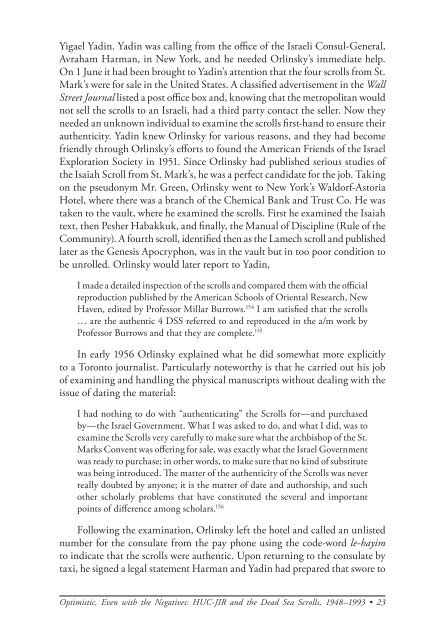The American Jewish Archives Journal, Volume LXI 2009, Number 1
The American Jewish Archives Journal, Volume LXI 2009, Number 1
The American Jewish Archives Journal, Volume LXI 2009, Number 1
You also want an ePaper? Increase the reach of your titles
YUMPU automatically turns print PDFs into web optimized ePapers that Google loves.
Yigael Yadin. Yadin was calling from the office of the Israeli Consul-General,<br />
Avraham Harman, in New York, and he needed Orlinsky’s immediate help.<br />
On 1 June it had been brought to Yadin’s attention that the four scrolls from St.<br />
Mark’s were for sale in the United States. A classified advertisement in the Wall<br />
Street <strong>Journal</strong> listed a post office box and, knowing that the metropolitan would<br />
not sell the scrolls to an Israeli, had a third party contact the seller. Now they<br />
needed an unknown individual to examine the scrolls first-hand to ensure their<br />
authenticity. Yadin knew Orlinsky for various reasons, and they had become<br />
friendly through Orlinsky’s efforts to found the <strong>American</strong> Friends of the Israel<br />
Exploration Society in 1951. Since Orlinsky had published serious studies of<br />
the Isaiah Scroll from St. Mark’s, he was a perfect candidate for the job. Taking<br />
on the pseudonym Mr. Green, Orlinsky went to New York’s Waldorf-Astoria<br />
Hotel, where there was a branch of the Chemical Bank and Trust Co. He was<br />
taken to the vault, where he examined the scrolls. First he examined the Isaiah<br />
text, then Pesher Habakkuk, and finally, the Manual of Discipline (Rule of the<br />
Community). A fourth scroll, identified then as the Lamech scroll and published<br />
later as the Genesis Apocryphon, was in the vault but in too poor condition to<br />
be unrolled. Orlinsky would later report to Yadin,<br />
I made a detailed inspection of the scrolls and compared them with the official<br />
reproduction published by the <strong>American</strong> Schools of Oriental Research, New<br />
Haven, edited by Professor Millar Burrows. 154 I am satisfied that the scrolls<br />
… are the authentic 4 DSS referred to and reproduced in the a/m work by<br />
Professor Burrows and that they are complete. 155<br />
In early 1956 Orlinsky explained what he did somewhat more explicitly<br />
to a Toronto journalist. Particularly noteworthy is that he carried out his job<br />
of examining and handling the physical manuscripts without dealing with the<br />
issue of dating the material:<br />
I had nothing to do with “authenticating” the Scrolls for—and purchased<br />
by—the Israel Government. What I was asked to do, and what I did, was to<br />
examine the Scrolls very carefully to make sure what the archbishop of the St.<br />
Marks Convent was offering for sale, was exactly what the Israel Government<br />
was ready to purchase; in other words, to make sure that no kind of substitute<br />
was being introduced. <strong>The</strong> matter of the authenticity of the Scrolls was never<br />
really doubted by anyone; it is the matter of date and authorship, and such<br />
other scholarly problems that have constituted the several and important<br />
points of difference among scholars. 156<br />
Following the examination, Orlinsky left the hotel and called an unlisted<br />
number for the consulate from the pay phone using the code-word le-hayim<br />
to indicate that the scrolls were authentic. Upon returning to the consulate by<br />
taxi, he signed a legal statement Harman and Yadin had prepared that swore to<br />
Optimistic, Even with the Negatives: HUC-JIR and the Dead Sea Scrolls, 1948–1993 • 23

















